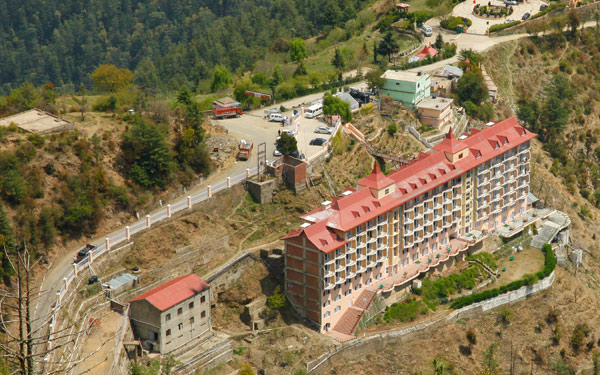|
|||||||||||||||
|
|||||||||||||||
Indian Elephant
Zoological name : Elephas maximus Range : The Indian Elephant is found across India in protected forests and in Nepal, Bhutan, Bangladesh and Myanmar. Estimated population : It is estimated that there are over 28,000 Indian Elephants in India, including zoos and animal parks. Physical characteristics : Elephants are the largest of all mammals on land. The Indian elephant is smaller than the African elephant, however it can grow up to 11 feet tall and weigh up to 5 tons. The elephant's brain is the heaviest of all land mammals and can weigh up to 5 Kg. Elephants have large ears, are covered with gray hairy skin, and are characterized by their long trunks which can be used in a number of ways including for breathing, to suck in water or food, to lift and pull objects, and to make trumpeting noises and other sounds for communication. All male Indian elephants do not have tusks. Elephants that do have large tusks are hunted by poachers who seek the tusks for their ivory. The tusks, which are elongated incisor teeth, are used for digging, pushing and fighting with other male elephants. The molar teeth which elephants use for chewing are located within their mouths and are replaced as they get worn out, until about age 40. Habitat : The Indian Elephant is found in the wild in densely forested areas of India including the tropical forests of South India, North East India and the sub Himalayan region. Also known as the Asian Elephant it is found in Sri Lanka, Bangladesh, Bhutan, Nepal, Thailand, Malaysia, Myanmar, Viet Nam, Cambodia, Indonesia, Laos and China. Diet : Elephants are herbivorous creatures and spend a large amount of time everyday eating up to 300 Kg of vegetation, including grass, leaves, fruit and the bark of trees. The length of an elephant's digestive system is around 100 feet. Elephants that are tamed are fed on leaves, sugarcane, bananas and rice gruel. Behavior : Elephants have a complex social structure. In the wild they live in family groups led by mature female elephants, their young and sometimes older bull elephants. Mature male elephants are often solitary or live in small groups of male elephants only. Elephants live up to 70 years old and can sleep while standing. Tame elephants are made to sit or lie down while its trainer or mahout attends to it, in the wild however an elephant will not lie down unless it is sick. Elephants enjoy wallowing in water, which helps clean their skin, which does not have any sweat glands. Adult male elephants around the age of 20 undergo a phase of heightened sexual urge known as "musth." Male elephants become aggressive and violent for a phase lasting up to 60 days. This phase recurs periodically through an adult male elephant's life. Status : Indian Elephants are threatened by poaching for their tusks, by the loss of habitat due to human pressure on forested areas and due to human conflict. The isolated populations of wild elephants in individual wildlife sanctuaries are also threatened by loss of genetic diversity. Recently a number of corridors connecting wildlife sanctuaries have been established to encourage the migration of wild elephants. Tourists can see the Indian Elephant in most of the national parks in India while traveling on India wildlife tours: Periyar National Park in Kerala in South India and Corbett National Park in Uttaranchal in North India, are some of the best sanctuaries where Indian elephants can be observed in their natural habitat. |
| Corporate Information | Partner with Us | Customer Care | Top Destination | Top Deals | ||||||||||
| About Us | Hotels in India | FAQ | Goa Tours | Goa Tour Packages | ||||||||||
| Our Team | Become a Affiliate | Contact Us | Rajasthan Tours | North India Tour Packages | ||||||||||
| Make My Trip Planner | Register your Hotel | Himachal Pradesh | Honeymoon Tour Packages | |||||||||||
| Board of Directors | Advertise with Us | Kerala Tour | Adventure tours India | |||||||||||
| Blog | Career | Pilgrimage Tours | Golden Triangle Tour | |||||||||||
| Holidays Packages India | Useful Links | All Destinations | North East India Tour Packages | |||||||||||









 Also known as the Asian elephant, the Indian Elephant is a gentle giant. Often tamed for use as a load-bearing animal, elephants are prized for their immense strength, their sedate nature when tamed and are worshipped in India as an incarnation of the elephant headed god Ganesha. Tame elephants are often kept in temples in India and bear the images of the gods in temple processions on festive days. Elephants have been used historically in India as the mounts of rulers, and as a part of warfare.
Also known as the Asian elephant, the Indian Elephant is a gentle giant. Often tamed for use as a load-bearing animal, elephants are prized for their immense strength, their sedate nature when tamed and are worshipped in India as an incarnation of the elephant headed god Ganesha. Tame elephants are often kept in temples in India and bear the images of the gods in temple processions on festive days. Elephants have been used historically in India as the mounts of rulers, and as a part of warfare.  Female elephants can bear young around the age of 16. Usually one, but sometimes two, offspring are born at a time. Elephants give birth to about 4 young ones over a span of 60 years. Elephants communicate through a variety of noises, including infrasonic sounds, which are inaudible to human beings.
Female elephants can bear young around the age of 16. Usually one, but sometimes two, offspring are born at a time. Elephants give birth to about 4 young ones over a span of 60 years. Elephants communicate through a variety of noises, including infrasonic sounds, which are inaudible to human beings.